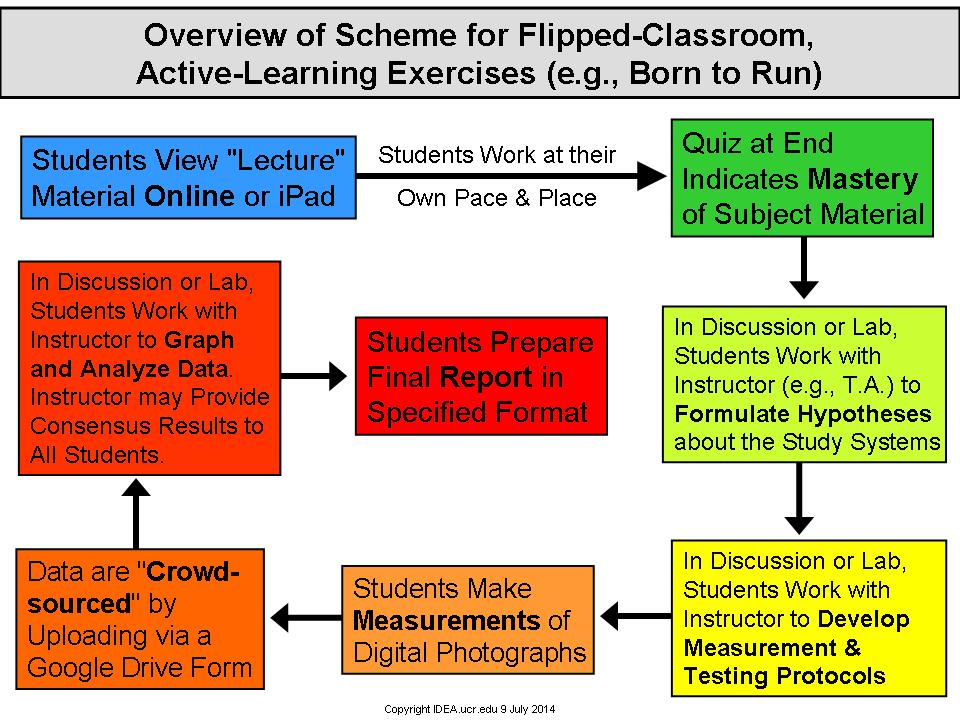Rationale & Principles
Educational methods are always being renewed, reinvented, and even transformed as new technologies become available. The internet has revolutionized course delivery in many ways, including the routine posting of lecture "notes" (e.g., slides from PowerPoint presentations) on course websites, online learning exercises, and even the development of entire courses and degree-granting programs that occur entirely online.
The development of extensive online content and mobile apps has the potential to revolutionize the delivery of educational content. Students are be able to learn (difficult) material at their own pace, in a convenient and inexpensive way (no textbook required, and many already own a smart phone, tablet or laptop). Many middle-school, high-school, and college students already spend a lot of time online, and this fact should encourage them to spend some of it with an engaging educational app. Indeed, studies have shown that students who study on mobile apps spend more time studying.
Our materials will be free. Although a nominal charge could help to support our ongoing efforts, any cost can be an impediment to at least some potential users. Moreover, a substantial part of our effort is supported by our positions at educational institutions and/or from federal grants that encourage or even require broader impacts and outreach efforts.
Our materials will help educators meet the Next Generation Science Standards, the Common Core State Standards, and STEM approaches in general. For example, the Born to Run lesson plan helps meet the NGSS Middle School: Natural Selection & Adaptations: MS-LS4-a, d: Analyzing & Interpreting Data, and also allows for cross-curricular options involving math and computer teachers.
Researchers should have the lesson plan or app in the back of their minds as they develop research projects and programs. Communicating the ideas behind basic and applied research to students and to the general public is of crucial importance for our society -- and for convincing voters that we need to invest more in research. Often, the introduction or background section to a grant application or research proposal could easily be ported to an educational app or online learning module. Research "specimens" in the form of digital images, raw tables of data, etc., can be made available for use in active-learning exercises (e.g., see Born to Run: Artificial Selection Lab). Doing so does not necessarily involve extra work for the researcher, as more and more granting agencies and journals are requiring that raw data be made available.
Apps and online exercises can be a tool for data collection and crowdsourcing of data. In Born to Run, users make measurements of digital research photos of mouse bones. These photographs are of actual specimens used in scientific research. Hence, it is possible for users to gather new measurements from these images, and these data could be consolidated in an online resource. Importantly, users have the opportunity to do new science, with original research materials (the digital photographs), not just cook-book exercises! A major goal of IDEA will be to bring this type of learning exercise into wider use. This general scheme can also be worked into Citizen Science efforts.
Wikipedia is a good source of content that is too extensive to fit within an app. Many of us edit Wikipedia pages in an attempt to improve the quality and quantity of their content. An extension of this practice will be to add content that is relevant for a particular app we are developing, and then refer to that Wikipedia page from within the app. An added benefit of this approach is that the content becomes instantly available to anyone within an internet connection.
YouTube is a good source of content. The entire world seems to be depicted on YouTube. Existing and new educational videos can add excitement and engage users. Some interesting examples include the following:
http://www.youtube.com/watch?v=c0msBWyTzU0
http://www.youtube.com/watch?v=K7tQIB4UdiY
http://www.youtube.com/watch?v=bN_TUPbZucU
We can create new YouTube content to provide background material, demonstrate techniques, show the results of computer simulations, etc., and then access these via our apps or internet-based educational media.
Other online sources can be used to outsource content. Various federal and state agencies, as well as non-profit and for-profit organizations, maintain web resources that can be referred to from within an app. Such outsourcing of content will require maintenance in terms of making sure links have not changed, etc., but that effort may be small compared with the effort required to create new content. This also avoids inefficiencies related to duplication of efforts. Examples of useful websites include the following:
Understanding Evolution
Shape Your Family’s Habits: Helping Kids Make Healthy Choices
Is Obesity a Disease?
Obesity and Energetics Offerings
Comparative Mammalian Brain Collections (digital images)
Trait Evolution on a Phylogenetic Tree
"Gamification" approaches can make content more appealing to students at various levels. According to Wikipedia (accessed 25 Jan. 2014), "Gamification is the use of game thinking and game mechanics in non-game contexts to engage users in solving problems. Gamification is applied to improve user engagement, return on investment, data quality, timeliness, and learning."
